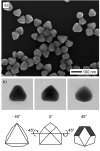Etching and growth: an intertwined pathway to silver nanocrystals with exotic shapes
- PMID: 19479923
- PMCID: PMC2922693
- DOI: 10.1002/anie.200901447
Etching and growth: an intertwined pathway to silver nanocrystals with exotic shapes
Abstract
Two-faced nanocrystals: Rapid addition of a second aliquot of silver nitrate during a polyol synthesis led to the formation of anisotropically truncated octahedrons as a result of oxidative etching and overgrowth of silver nanocubes. Three adjacent faces of the nanocube grew more rapidly than the three other faces, generating a non-centrosymmetric structure (see picture).
Figures




Similar articles
-
Dissolution-recrystallization mechanism for the conversion of silver nanospheres to triangular nanoplates.J Colloid Interface Sci. 2007 Apr 1;308(1):157-61. doi: 10.1016/j.jcis.2006.12.081. Epub 2007 Jan 11. J Colloid Interface Sci. 2007. PMID: 17240390
-
Silver nanoparticles-decorated polyphosphazene nanotubes: synthesis and applications.Nanoscale. 2013 Sep 7;5(17):7913-9. doi: 10.1039/c3nr00010a. Nanoscale. 2013. PMID: 23852037
-
Unstable reshaping of gold nanorods prepared by a wet chemical method in the presence of silver nitrate.J Nanosci Nanotechnol. 2006 Nov;6(11):3355-9. doi: 10.1166/jnn.2006.009. J Nanosci Nanotechnol. 2006. PMID: 17252764
-
Shape-dependent catalytic activity of silver nanoparticles for the oxidation of styrene.Chem Asian J. 2006 Dec 18;1(6):888-93. doi: 10.1002/asia.200600260. Chem Asian J. 2006. PMID: 17441132
-
Shape-controlled synthesis of Pd nanocrystals and their catalytic applications.Acc Chem Res. 2013 Aug 20;46(8):1783-94. doi: 10.1021/ar300209w. Epub 2012 Nov 19. Acc Chem Res. 2013. PMID: 23163781 Review.
Cited by
-
Bioavailability of silver nanoparticles and ions: from a chemical and biochemical perspective.J R Soc Interface. 2013 Jul 24;10(87):20130396. doi: 10.1098/rsif.2013.0396. Print 2013 Oct 6. J R Soc Interface. 2013. PMID: 23883950 Free PMC article. Review.
-
Electrochemically Created Highly Surface Roughened Ag Nanoplate Arrays for SERS Biosensing Applications.J Mater Chem C Mater. 2014 Oct 21;2(39):8350-8356. doi: 10.1039/C4TC01276C. J Mater Chem C Mater. 2014. PMID: 25383191 Free PMC article.
-
Quantitative analysis of the role played by poly(vinylpyrrolidone) in seed-mediated growth of Ag nanocrystals.J Am Chem Soc. 2012 Jan 25;134(3):1793-801. doi: 10.1021/ja210047e. Epub 2012 Jan 13. J Am Chem Soc. 2012. PMID: 22206387 Free PMC article.
-
Synthesis and biological characterization of alloyed silver-platinum nanoparticles: from compact core-shell nanoparticles to hollow nanoalloys.RSC Adv. 2018 Nov 15;8(67):38582-38590. doi: 10.1039/c8ra06461j. eCollection 2018 Nov 14. RSC Adv. 2018. PMID: 35559054 Free PMC article.
-
Controlling the synthesis and assembly of silver nanostructures for plasmonic applications.Chem Rev. 2011 Jun 8;111(6):3669-712. doi: 10.1021/cr100275d. Epub 2011 Mar 11. Chem Rev. 2011. PMID: 21395318 Free PMC article. Review. No abstract available.
References
-
- Aiken JD, III, Finke RG. J. Mol Catal. A.: Chem. 1999;145:1.
- Lewis LN. Chem. Rev. 1993;93:2693.
-
- Xia Y, Yang P, Sun Y, Wu Y, Mayers B, Gates B. Adv. Mater. 2003;15:353.
-
- Nie S, Emory S. Science. 1997;275:1102. - PubMed
- Haynes CL, Van Duyne RP. J. Phys. Chem. B. 2001;105:5599.
Publication types
MeSH terms
Substances
Grants and funding
LinkOut - more resources
Full Text Sources

